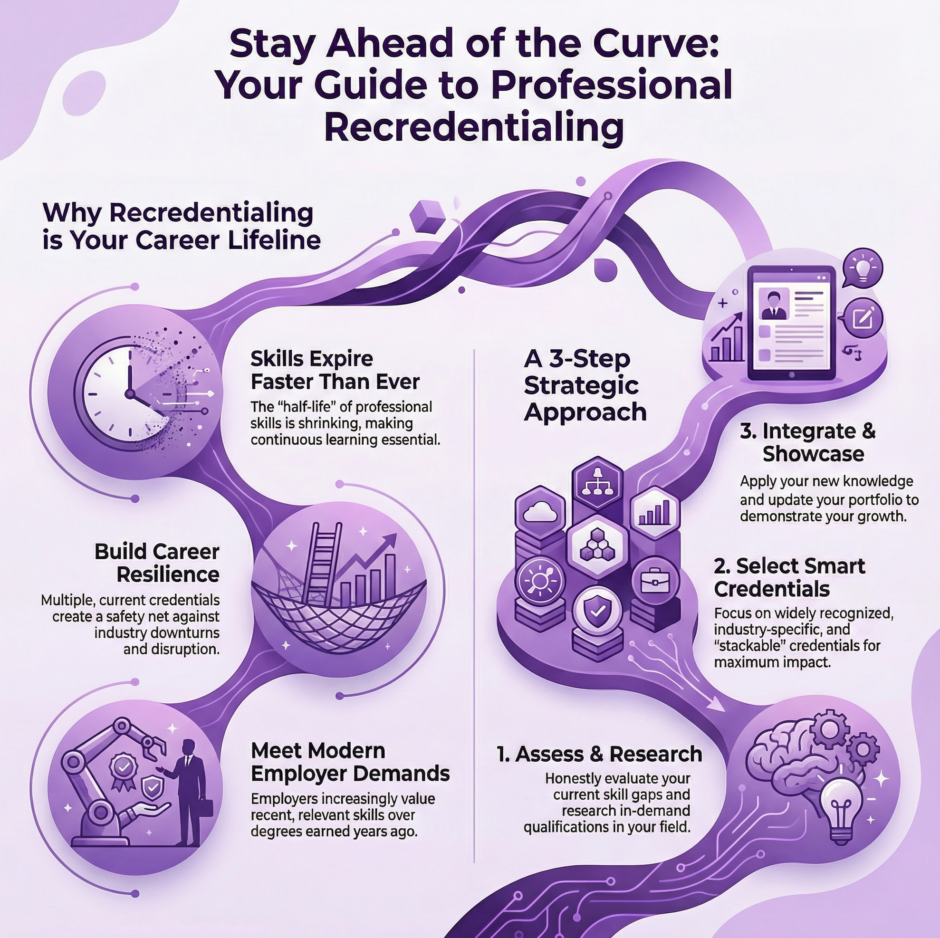
The professional landscape is shifting faster than ever before. Technologies emerge overnight, industries transform, and the skills that got you where you are today might not be enough to take you where you want to go tomorrow. That’s where recredentialing comes in, your strategic approach to staying relevant, competitive, and excited about your career journey.
Think of recredentialing as hitting the refresh button on your professional identity. It’s not about starting over or admitting defeat. Instead, it’s about consciously choosing to evolve, adapt, and expand your expertise in ways that align with both market demands and your personal aspirations.
What Recredentialing Really Means
At its core, recredentialing is the process of obtaining new credentials, certifications, or qualifications to supplement or replace your existing professional qualifications. This might involve pursuing additional certifications in your current field, branching into complementary areas, or even pivoting to an entirely new industry.
 The beauty of recredentialing lies in its flexibility. You’re not locked into one path or timeline. You can pursue microcredentials that take weeks to complete, or embark on comprehensive programs that span months or years. The key is matching your recredentialing strategy to your specific goals and circumstances.
The beauty of recredentialing lies in its flexibility. You’re not locked into one path or timeline. You can pursue microcredentials that take weeks to complete, or embark on comprehensive programs that span months or years. The key is matching your recredentialing strategy to your specific goals and circumstances.
Modern provider recredentialing encompasses everything from traditional degree programs and professional certifications to digital badges, industry-specific training, and even self-directed learning paths. The digital age has democratized access to high-quality education and training, making it easier than ever to acquire new skills and validate your expertise.
Why Recredentialing Matters More Than Ever

The half-life of skills is shrinking rapidly across virtually every industry. What you learned five years ago might already be outdated, and what’s cutting-edge today could be standard practice tomorrow. Recredentialing helps you stay ahead of this curve rather than constantly playing catch-up.
Economic uncertainty has made career resilience a priority for professionals at every level. Having multiple skill sets and credentials creates a safety net that protects you from industry downturns, company restructuring, or technological disruption. It’s like having multiple keys that can unlock different doors when your current path becomes blocked.
The gig economy and remote work have also changed how employers evaluate candidates. They’re increasingly looking for proof of current, relevant skills rather than relying solely on past experience or degrees earned years ago. Fresh credentials signal that you’re actively engaged in professional development and committed to excellence.
Furthermore, many industries now require ongoing education and recertification to maintain professional standing. Healthcare, technology, finance, and education are just a few sectors where staying current isn’t optional, it’s mandatory. Recredentialing helps you meet these requirements while potentially exceeding minimum standards.
The Strategic Approach to Recredentialing
Successful recredentialing starts with honest self-assessment. Take inventory of your current skills, identify gaps in your knowledge, and research where your industry is heading. This foundation helps you make informed decisions about which credentials will provide the most value for your time and investment.
 Market research is equally important. Look at job postings in your target roles and note which qualifications appear most frequently. Talk to professionals who are already where you want to be and ask about their credential journey. Professional associations often publish reports on emerging trends and recommended qualifications that can guide your decisions.
Market research is equally important. Look at job postings in your target roles and note which qualifications appear most frequently. Talk to professionals who are already where you want to be and ask about their credential journey. Professional associations often publish reports on emerging trends and recommended qualifications that can guide your decisions.
Consider your learning style and schedule when choosing recredentialing options. Some people thrive in structured classroom environments, while others prefer self-paced online learning. Some can commit to intensive boot camps, while others need programs that accommodate busy work schedules and family responsibilities.
Financial planning is another crucial element. While many recredentialing options are more affordable than traditional degrees, costs can still add up. Research scholarships, employer tuition assistance programs, and tax benefits that might help offset expenses. Recredentialing is an investment in your future earning potential.
Negotiating the Recredentialing Landscape
The sheer number of recredentialing options available today can feel overwhelming. Start by focusing on credentials that are widely recognized and respected in your target industry. Look for programs offered by established institutions, professional organizations, or technology companies with strong reputations.
Industry-specific certifications often carry more weight than generic credentials. A project management certification might be valuable across many fields, but a specialized certification in cybersecurity or data analytics could open doors to specific high-demand roles.
Don’t overlook the power of stackable credentials. Many modern programs are designed to build upon each other, allowing you to start with a foundational certificate and gradually work toward more advanced qualifications. This approach lets you demonstrate progress and apply new skills immediately while working toward larger goals.
Online learning platforms have revolutionized access to quality education and training. Many offer credentials from top universities and industry leaders at a fraction of the cost of traditional programs. However, be selective about which online credentials you pursue, as recognition and value can vary significantly.
Making Recredentialing Work for You
Timing your recredentialing efforts strategically can maximize their impact on your career. Consider pursuing new credentials during slower periods at work, between jobs, or when you’re preparing for a promotion or career transition. Having new qualifications in hand before you need them puts you in a stronger negotiating position.
Integration is key to getting the most value from your recredentialing process efforts. Look for opportunities to apply new knowledge immediately, whether through projects at your current job, volunteer work, or side ventures. This practical application reinforces learning and demonstrates your capabilities to current and potential employers.
Building a portfolio that showcases your recredentialing journey can be incredibly powerful. Document projects, share insights on professional networks, and maintain an updated resume that clearly presents your expanding skill set. Many professionals create online portfolios or personal websites that tell the story of their professional evolution.
Networking within your recredentialing programs opens doors beyond just acquiring new knowledge. Your classmates and instructors become part of your professional network, potentially leading to job opportunities, collaborations, or mentorship relationships. Take advantage of discussion forums, study groups, and alumni networks.
Overcoming Common Recredentialing Challenges
Time management is often the biggest hurdle in recredentialing efforts. Success requires treating your professional development like a priority rather than something to fit in when convenient. Create a realistic study schedule, eliminate time-wasters, and consider how you can optimize your learning efficiency.
 Imposter syndrome frequently surfaces during recredentialing, especially when entering new fields or tackling advanced topics. Remember that everyone starts somewhere, and the discomfort of learning something new is temporary. Focus on progress rather than perfection, and celebrate small wins along the way.
Imposter syndrome frequently surfaces during recredentialing, especially when entering new fields or tackling advanced topics. Remember that everyone starts somewhere, and the discomfort of learning something new is temporary. Focus on progress rather than perfection, and celebrate small wins along the way.
Information overload is another common challenge. With so many resources available, it’s easy to get distracted by every new course or certification that catches your eye. Stay focused on your strategic plan and resist the temptation to chase every shiny new credential that appears.
Maintaining motivation throughout longer recredentialing programs requires ongoing effort. Set milestone goals, find study partners or accountability groups, and regularly remind yourself why you started this journey. Visualizing your end goals and the benefits they’ll bring can help you push through difficult periods.
The Future of Professional Development
 Recredentialing is becoming the new normal rather than an occasional career boost. The most successful professionals are those who view learning as a continuous process rather than something that ends after formal education. This mindset shift positions you to thrive in an economy that increasingly rewards adaptability and growth.
Recredentialing is becoming the new normal rather than an occasional career boost. The most successful professionals are those who view learning as a continuous process rather than something that ends after formal education. This mindset shift positions you to thrive in an economy that increasingly rewards adaptability and growth.
Artificial intelligence and automation are changing skill requirements across industries, but they’re also creating new opportunities for those willing to acquire relevant credentials. The professionals who embrace recredentialing now will be best positioned to work alongside and manage these new technologies.
Micro-learning and just-in-time training are becoming more prevalent, allowing professionals to acquire specific skills exactly when they need them. This trend makes recredentialing more flexible and responsive to immediate career needs while reducing the time and cost barriers that previously limited access to professional development.
Contact us to handle all of your recredentialing needs and/or challenges.
